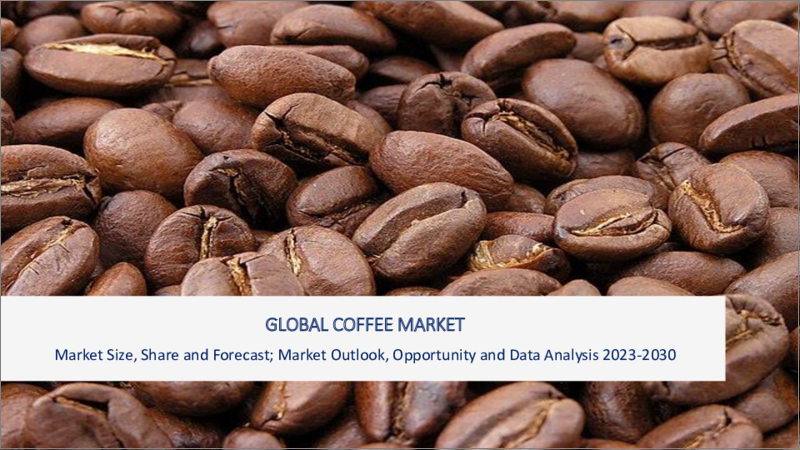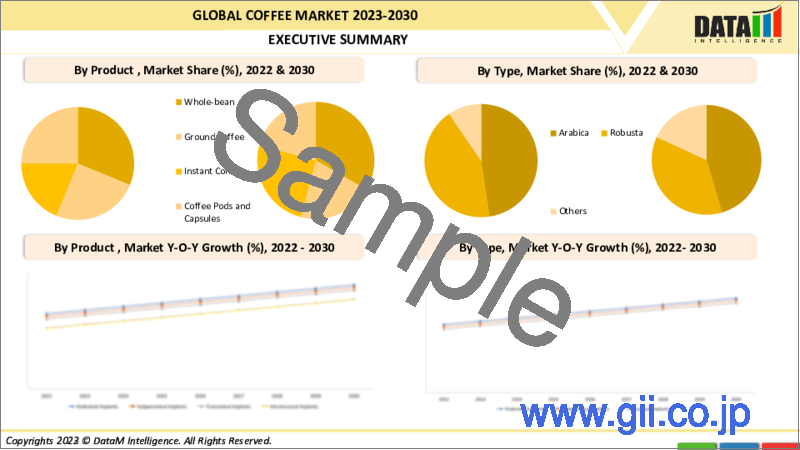|
|
市場調査レポート
商品コード
1316270
コーヒーの世界市場-2023年~2030年Global Coffee Market - 2023-2030 |
||||||
カスタマイズ可能
適宜更新あり
|
|||||||
| コーヒーの世界市場-2023年~2030年 |
|
出版日: 2023年07月27日
発行: DataM Intelligence
ページ情報: 英文 122 Pages
納期: 即日から翌営業日
|
- 全表示
- 概要
- 目次
市場概要
世界のコーヒー市場は2022年に1,229億米ドルに達し、2023~2030年の予測期間中にCAGR 4.2%で成長し、2030年には1,708億米ドルに達すると予測されます。
スペシャルティコーヒーの需要は増加の一途をたどっており、消費者はユニークなフレーバー、高品質の豆、倫理的な調達を求め、スペシャルティコーヒーショップや職人的な焙煎業者の成長を牽引しています。コーヒー・ブレンドは、それぞれ異なる風味を持つコーヒー豆を丹念に組み合わせ、各成分の長所を生かした調和のとれたバランスの取れた一杯を作り出すものです。コールドブリュー、缶コーヒー、コーヒーベースのエナジードリンクなど、すぐに飲めるコーヒー飲料の人気は急上昇しており、外出の多いライフスタイルや利便性を求める消費者に対応しています。
コーヒー豆の種類(アラビカ種、ロブスタ種)、栽培地域、標高、加工方法、焙煎技術などの要因に影響され、コーヒーの品種は多様な風味と特徴を包含しており、コーヒー愛好家に膨大な種類のユニークな味覚体験を提供しています。コーヒーの焙煎は、生豆を注意深く制御された熱を加えることによって、香り高く風味豊かな焙煎コーヒーに変えるプロセスです。コーヒーの抽出は、お湯とコーヒーの粉を合わせることによって、挽いたコーヒー豆から豊かな風味、アロマ、カフェインを抽出する技術であり、ポアオーバー、エスプレッソ、フレンチプレス、ドリップ抽出など様々な方法があります。
市場力学
コーヒー消費による健康効果と認知度の向上がコーヒー市場の成長を牽引
コーヒーを定期的に摂取することで、2型糖尿病、肝臓疾患(肝硬変や肝臓がんなど)、ある種のがん(結腸直腸がんや子宮内膜がんなど)など、特定の疾患のリスクが低下する可能性が複数の研究で示唆されています。適度なコーヒーの摂取は、心臓発作、脳卒中、心不全などの心血管疾患のリスク低減と関連しています。コーヒーに含まれる抗酸化物質が血管機能を改善し、炎症を抑えることで、心臓の健康に役立つ可能性があります。
コーヒーは、代謝を高め、体重管理を助けるなど、潜在的な代謝上の利点があることがわかっています。また、インスリン感受性を改善し、血糖値の調節を助ける可能性もあります。コーヒーに含まれるカフェインはアドレナリン濃度を高め、運動時の身体能力や持久力を向上させる。また、筋肉痛を軽減し、運動後の筋肉の回復を高める効果もあります。
様々な種類のコーヒーが入手可能になったことがコーヒー市場の成長を促進
様々な種類のコーヒーが手に入るようになったことが、コーヒー市場の成長に大きく寄与しています。今日、コーヒーを飲む人々は、スペシャルティコーヒードリンク、フレーバーコーヒー、アイスコーヒー、コールドブリュー、シングルオリジンコーヒー、職人ブレンドなど、伝統的な抽出コーヒー以外にも幅広い選択肢を持っています。コーヒーショップ・チェーン、独立系コーヒーショップ、スペシャリティ・カフェの拡大により、消費者は多様なコーヒー飲料に簡単にアクセスできるようになっています。こうした店では多くのメニューが用意され、様々な風味、抽出方法、産地のコーヒーを楽しむことができます。
様々なタイプのコーヒーの製品タイプの増加は、予測期間中のコーヒー市場の成長を後押しします。例えば、2023年4月20日、大手コーヒーブランドであるChamberlain Coffeeは、植物ベースのコールドブリューラテの新しいRTD(Ready To Drink)ラインを発売しました。Chamberlain CoffeeのRTD飲料は、Walmartのレディ・トゥ・ドリンク・コーヒー売り場でのみ販売されています。
代替飲料としての紅茶人気の高まりがコーヒー市場の成長を妨げる
紅茶は一般的にコーヒーよりもカフェイン含有量が少ないです。カフェイン含有量が少ないため、カフェインに敏感な人や、よりマイルドな刺激を好む人に好まれます。紅茶愛好家の中には、コーヒー摂取に伴う急激なスパイクとクラッシュに比べ、紅茶が提供する緩やかで持続的なエネルギー増強を高く評価する人もいます。紅茶は、中国、日本、インド、英国など、世界中の多くの地域で文化的に深い意味を持っています。これらの飲茶文化の影響は、グローバリゼーションと旅行の増加と相まって、世界各地での紅茶の普及と評価に寄与しています。
主要プレーヤーによる新製品発売の増加が、紅茶市場の成長を後押ししています。例えば、2023年2月20日、Laval Green Tea社はインドで発泡性緑茶を発売しました。この企業の緑茶タブレットは、従来の緑茶タブレットの最も便利なオプションです。これは、健康を高めるのに役立つ栄養素と抗酸化物質が詰まっています。この錠剤は100%オーガニックの高品質の緑茶エキスから作られています。
COVID-19の影響
COVID-19は世界のサプライチェーンに混乱をもたらし、生産国から消費市場へのコーヒー豆の移動に影響を与えました。ロックダウン、渡航制限、輸送能力の低下により、出荷の遅れと物流の困難が生じ、コーヒーの入手と流通に影響を与えました。封鎖措置によるカフェ、レストラン、その他の外食施設の閉鎖は、家庭外でのコーヒー消費量の大幅な減少につながっています。人々が家に閉じこもり、社会から距離を置くようになったため、こうした店でのコーヒーの需要は激減し、コーヒー事業者の収入減と財務上の課題につながっています。
人々が自宅で過ごす時間が長くなるにつれて、家庭でコーヒーを淹れることに消費者の行動が顕著に変化しました。多くの人々が自宅でコーヒーを淹れるようになり、ホールビーンズ、挽いたコーヒー、シングルサーブコーヒーポッドなどの小売コーヒー製品の需要が増加しました。この変化は小売コーヒーブランドやeコマースプラットフォームに利益をもたらしました。コーヒー生産国はパンデミックの間、多くの課題に直面しました。海外渡航が制限されたことで、コーヒーの収穫や加工に従事する季節労働者が制限され、労働力不足と収穫量の減少につながっています。
ロシア・ウクライナ間の影響分析
ロシアとウクライナの政治的緊張は、貿易の混乱と不確実性をもたらしました。ウクライナはコーヒーの主要生産国であり、ロシアはコーヒーの主要消費国です。貿易制限、関税、政治的紛争は両国間のコーヒーの流れに障害をもたらし、サプライチェーンや市場力学に影響を与えます。
ロシアとウクライナの紛争は、コーヒーの輸出入に変化をもたらしました。ウクライナはコーヒーの生産が盛んであることで知られているが、政治的緊張のため、ロシア市場への輸出に課題が生じる可能性があります。同様に、ロシアのコーヒー輸入業者も、ウクライナ産コーヒーへの依存度を下げるために、代替調達を模索する可能性があります。その結果、貿易パターンが変化し、供給網が再構築される可能性があります。
目次
第1章 調査手法と調査範囲
第2章 定義と概要
第3章 エグゼクティブサマリー
第4章 市場力学
- 影響要因
- 促進要因
- 抑制要因
- 機会
- 影響分析
第5章 産業分析
- ポーターのファイブフォース分析
- サプライチェーン分析
- 価格分析
- 規制分析
第6章 COVID-19分析
第7章 タイプ別
- アラビカ
- ロブスタ
第8章 流通チャネル別
- スーパーマーケット/ハイパーマーケット
- 小売店
- コーヒー専門店
- eコマース
- その他
第9章 用途別
- 飲料
- 食品・飲料フレーバー
- ヘルスケア
- 化粧品
- その他
第10章 地域別
- 北米
- 米国
- カナダ
- メキシコ
- 欧州
- ドイツ
- 英国
- フランス
- イタリア
- スペイン
- その他欧州
- 南米
- ブラジル
- アルゼンチン
- その他南米
- アジア太平洋
- 中国
- インド
- 日本
- オーストラリア
- その他アジア太平洋地域
- 中東・アフリカ
第11章 競合情勢
- 競合シナリオ
- 市況/シェア分析
- M&A分析
第12章 企業プロファイル
- Nestle
- 会社概要
- 製品ポートフォリオと説明
- 財務概要
- 主な発展
- Jacobs Douwe Egberts
- Smuckers
- Starbucks
- Strauss
- Lavazza
- Ueshima Coffee Co.
- Tchibo
- Massimo Zanetti
- The Coca Cola Company
第13章 付録
Market Overview
The Global Coffee Market reached US$ 122.9 billion in 2022 and is expected to reach US$ 170.8 billion by 2030 growing with a CAGR of 4.2% during the forecast period 2023-2030.
The demand for specialty coffee continues to rise, with consumers seeking unique flavors, quality beans, and ethical sourcing, driving the growth of specialty coffee shops and artisanal roasters. Coffee blends are meticulously crafted combinations of different coffee beans, each with their distinct flavor profiles, to create a harmonious and balanced cup of coffee that showcases the best attributes of each component. The popularity of ready-to-drink coffee beverages, including cold brews, canned coffees, and coffee-based energy drinks, has soared, catering to the on-the-go lifestyle and convenience-seeking consumers.
Coffee varieties encompass a diverse range of flavors and characteristics, influenced by factors such as the type of coffee bean (Arabica or Robusta), growing region, altitude, processing methods, and roasting techniques, providing coffee lovers with a vast array of unique taste experiences. Coffee roasting is the process of transforming green coffee beans into aromatic and flavorful roasted coffee through carefully controlled heat application, enhancing the natural qualities of the beans and creating a delightful beverage enjoyed by millions worldwide. Coffee brewing is the art of extracting the rich flavors, aromas, and caffeine from ground coffee beans by combining hot water and coffee grounds in various methods such as pour-over, espresso, French press, or drip brewing, resulting in a satisfying and invigorating beverage.
Market Dynamics
Increase in Health Benefits and Awareness of the Coffee Consumption Drives Coffee Market Growth
Several studies have suggested that regular coffee consumption may lower the risk of certain diseases, including type 2 diabetes, liver diseases (such as liver cirrhosis and liver cancer), and certain types of cancer (such as colorectal and endometrial cancers). Moderate coffee consumption has been associated with a reduced risk of cardiovascular diseases, including heart attack, stroke, and heart failure. The antioxidants in coffee may help improve blood vessel function and reduce inflammation, which can benefit heart health.
Coffee has been found to have potential metabolic benefits, such as increasing metabolism and aiding in weight management. It may also improve insulin sensitivity and help regulate blood sugar levels. The caffeine in coffee can increase adrenaline levels, which can enhance physical performance and endurance during activities like exercise. It may also help reduce muscle pain and improve muscle recovery post-workout.
Increase in the Availability of Various Types of Coffee Options Drives Coffee Market Growth
The increase in the availability of various types of coffee options has significantly contributed to the growth of the coffee market. Coffee drinkers today have a wide range of choices beyond traditional brewed coffee, including specialty coffee drinks, flavored coffees, iced and cold brews, single-origin coffees, and artisanal blends. The expansion of coffee shop chains, independent coffee shops, and specialty cafes has made it easier for consumers to access a diverse selection of coffee beverages. These establishments often offer a menu with a plethora of options, allowing customers to explore different flavor profiles, brewing methods, and coffee origins.
Increase in the product launches of various types of the coffee helps to boost coffee market growth over the forecast period. For instance, On April 20, 2023, Chamberlain Coffee, a leading coffee brand launched a new line of Ready To Drink (RTD) plant-based cold brew lattes. The RTD beverages from Chamberlain Coffee are only available at Walmart in the ready-to-drink coffee department.
Growing Popularity of the Tea as Alternative Drink Hampers Coffee Market Growth
Tea generally contains less caffeine than coffee. This lower caffeine content appeals to individuals who are sensitive to caffeine or prefer a milder stimulant effect. Some tea enthusiasts appreciate the more gradual and sustained energy boost that tea provides compared to the rapid spike and crash associated with coffee consumption. Tea holds deep cultural significance in many regions around the world, such as China, Japan, India, and the United Kingdom. The influence of these tea-drinking cultures, combined with globalization and increased travel, has contributed to the spread and appreciation of tea in various parts of the world.
Increase in the new product launches by major key players helps to boost growth of tea market. For instance, On February 20 2023, Laval Green Tea launched effervescent green teain India. The companies green tea tablets are most convenient option to traditional green tea tablet. It is packed with nutrients and antioxidants which helps to boost health. These tablets are made from the high quality green tea extract which is 100% organic.
COVID-19 Impact
COVID-19 led to disruptions in the global supply chain, affecting the movement of coffee beans from producing countries to consuming markets. Lockdowns, travel restrictions, and reduced transportation capacity caused delays in shipments and logistical challenges, impacting the availability and distribution of coffee. The closure of cafes, restaurants, and other foodservice establishments due to lockdown measures resulted in a significant decline in out-of-home coffee consumption. With people staying at home and practicing social distancing, the demand for coffee in these establishments drastically decreased, leading to revenue losses and financial challenges for coffee businesses.
As people spent more time at home, there was a noticeable shift in consumer behavior towards home brewing. Many individuals turned to brewing their coffee at home, leading to an increased demand for retail coffee products, including whole beans, ground coffee, and single-serve coffee pods. This shift benefited retail coffee brands and e-commerce platforms. Coffee-producing countries faced numerous challenges during the pandemic. The restrictions on international travel limited the availability of seasonal workers for harvesting and processing coffee crops, leading to labor shortages and potential yield losses.
Russia-Ukraine Impact Analysis
The political tensions between Russia and Ukraine have resulted in trade disruptions and uncertainties. Both countries play significant roles in the coffee market, with Ukraine being a major coffee producer and Russia being a significant coffee consumer. Trade restrictions, tariffs, and political conflicts can create obstacles in the flow of coffee between the two countries, impacting supply chains and market dynamics.
The Russia-Ukraine conflict lead to changes in import and export dynamics for coffee. Ukraine, known for its robust coffee production, may face challenges in exporting coffee to the Russian market due to political tensions. Similarly, Russian coffee importers may seek alternative sourcing options to reduce reliance on Ukrainian coffee. This can result in shifts in trade patterns and a reconfiguration of supply networks.
Segment Analysis
The global coffee market is segmented based on form, type, distribution channel, and region.
Increase in the Consumers Demand for Robusta Due to its Taste
The global coffee market by type has been segmented by arabica, and robusta.
Consumers are increasingly seeking healthier beverage options, and Coffee drinks align well with this trend. Coffee drinks are perceived as a nutritious choice due to their probiotic content, which supports gut health, and their high protein content, which helps with satiety and muscle maintenance. The busy lifestyles of consumers have led to an increased demand for convenient and portable beverages. Coffee drinks provide a convenient option for a quick and nourishing snack or meal replacement, making them popular among busy individuals who prioritize nutrition on the go.
Major key players in the market launched new Coffee drink products in the market which helps to boost Coffee drink segment growth over the forecast period. For instance, On August 26 2021, Lactalis India launched protein-packed lactel turbo yoghurt drink in the market. It is on the go drink available in the strawberry and mango flavours. The beverage includes all of the advantages of natural, premium French-quality yoghurt.
Geographical Analysis
Increased Demand for Coffee in North America Region Due to its Health Benifits
United States and Canada are major share holding countries in the region due to increase demand for Coffee due to its health benifits. The North America Coffee market is a dynamic and competitive industry that has experienced consistent growth, driven by factors such as increasing consumer demand for healthy snacks, the popularity of Coffee as a breakfast option, and the availability of a wide range of flavors, formats, and specialty Coffees catering to diverse consumer preferences. The market is characterized by the presence of both established Coffee brands and innovative newcomers, as well as a growing emphasis on Coffee products with functional benefits, such as probiotics, high protein content, and low sugar options, in response to changing consumer lifestyles and dietary needs.
Canadian consumers are increasingly concerned about the environmental and ethical aspects of their food choices Also, increase in the merger, acquisition and partnership strategies in the region drives market growth. For instance, on November 17 2022, An broad line of plant-based seafood substitutes will be developed through a new partnership between Canadian companies Konscious Foods, Merit Coffees, and Canadian Pacifico Seaweeds.
Competitive Landscape
The major global players include: Nestle, Jacobs Douwe Egberts, Smuckers, Starbucks, Strauss, Lavazza, Ueshima Coffee Co., Tchibo, Massimo Zanetti and Coca-Cola Company.
Why Purchase the Report?
- To visualize the global coffee market segmentation based on type, distribution channel, and region, as well as understand key commercial assets and players.
- Identify commercial opportunities by analyzing trends and co-development.
- Excel data sheet with numerous data points of coffee market-level with all segments.
- PDF report consists of a comprehensive analysis after exhaustive qualitative interviews and an in-depth study.
- Product mapping available as excel consisting of key products of all the major players.
The global coffee market report would provide approximately 61 tables, 60 figures and 122 Pages.
Target Audience 2023
- Manufacturers/ Buyers
- Industry Investors/Investment Bankers
- Research Professionals
- Emerging Companies
Table of Contents
1. Methodology and Scope
- 1.1. Research Methodology
- 1.2. Research Objective and Scope of the Report
2. Definition and Overview
3. Executive Summary
- 3.1. Snippet by Type
- 3.2. Snippet by Distribution Channel
- 3.3. Snippet by Application
- 3.4. Snippet by Region
4. Dynamics
- 4.1. Impacting Factors
- 4.1.1. Drivers
- 4.1.2. Restraints
- 4.1.3. Opportunity
- 4.1.4. Impact Analysis
5. Industry Analysis
- 5.1. Porter's Five Force Analysis
- 5.2. Supply Chain Analysis
- 5.3. Pricing Analysis
- 5.4. Regulatory Analysis
6. COVID-19 Analysis
- 6.1. Analysis of COVID-19
- 6.1.1. Scenario Before Covid-19
- 6.1.2. Scenario During Covid-19
- 6.1.3. Scenario Post COVID-19
- 6.2. Pricing Dynamics Amid COVID-19
- 6.3. Demand-Supply Spectrum
- 6.4. Government Initiatives Related to the Market During Pandemic
- 6.5. Manufacturers Strategic Initiatives
- 6.6. Conclusion
7. By Type
- 7.1. Introduction
- 7.1.1. Market Size Analysis and Y-o-Y Growth Analysis (%), By Type
- 7.1.2. Market Attractiveness Index, By Type
- 7.2. Arabica*
- 7.2.1. Introduction
- 7.2.2. Market Size Analysis and Y-o-Y Growth Analysis (%)
- 7.3. Robusta
8. By Distribution Channel
- 8.1. Introduction
- 8.1.1. Market Size Analysis and Y-o-Y Growth Analysis (%), By Distribution Channel
- 8.1.2. Market Attractiveness Index, By Distribution Channel
- 8.2. Supermarkets/Hypermarkets*
- 8.2.1. Introduction
- 8.2.2. Market Size Analysis and Y-o-Y Growth Analysis (%)
- 8.3. Retail Stores
- 8.4. Coffee Specialty Stores
- 8.5. E-commerce
- 8.6. Others
9. By Application
- 9.1. Introduction
- 9.1.1. Market Size Analysis and Y-o-Y Growth Analysis (%), By Application
- 9.1.2. Market Attractiveness Index, By Application
- 9.2. Beverages*
- 9.2.1. Introduction
- 9.2.2. Market Size Analysis and Y-o-Y Growth Analysis (%)
- 9.3. Food and Beverage Flavors
- 9.4. Healthcare
- 9.5. Cosmetics
- 9.6. Others
10. By Region
- 10.1. Introduction
- 10.1.1. Market Size Analysis and Y-o-Y Growth Analysis (%), By Region
- 10.1.2. Market Attractiveness Index, By Region
- 10.2. North America
- 10.2.1. Introduction
- 10.2.2. Key Region-Specific Dynamics
- 10.2.3. Market Size Analysis and Y-o-Y Growth Analysis (%), By Type
- 10.2.4. Market Size Analysis and Y-o-Y Growth Analysis (%), By Distribution Channel
- 10.2.5. Market Size Analysis and Y-o-Y Growth Analysis (%), By Application
- 10.2.6. Market Size Analysis and Y-o-Y Growth Analysis (%), By Country
- 10.2.6.1. The U.S.
- 10.2.6.2. Canada
- 10.2.6.3. Mexico
- 10.3. Europe
- 10.3.1. Introduction
- 10.3.2. Key Region-Specific Dynamics
- 10.3.3. Market Size Analysis and Y-o-Y Growth Analysis (%), By Type
- 10.3.4. Market Size Analysis and Y-o-Y Growth Analysis (%), By Distribution Channel
- 10.3.5. Market Size Analysis and Y-o-Y Growth Analysis (%), By Application
- 10.3.6. Market Size Analysis and Y-o-Y Growth Analysis (%), By Country
- 10.3.6.1. Germany
- 10.3.6.2. The U.K.
- 10.3.6.3. France
- 10.3.6.4. Italy
- 10.3.6.5. Spain
- 10.3.6.6. Rest of Europe
- 10.4. South America
- 10.4.1. Introduction
- 10.4.2. Key Region-Specific Dynamics
- 10.4.3. Market Size Analysis and Y-o-Y Growth Analysis (%), By Type
- 10.4.4. Market Size Analysis and Y-o-Y Growth Analysis (%), By Distribution Channel
- 10.4.5. Market Size Analysis and Y-o-Y Growth Analysis (%), By Application
- 10.4.6. Market Size Analysis and Y-o-Y Growth Analysis (%), By Country
- 10.4.6.1. Brazil
- 10.4.6.2. Argentina
- 10.4.6.3. Rest of South America
- 10.5. Asia-Pacific
- 10.5.1. Introduction
- 10.5.2. Key Region-Specific Dynamics
- 10.5.3. Market Size Analysis and Y-o-Y Growth Analysis (%), By Type
- 10.5.4. Market Size Analysis and Y-o-Y Growth Analysis (%), By Distribution Channel
- 10.5.5. Market Size Analysis and Y-o-Y Growth Analysis (%), By Application
- 10.5.6. Market Size Analysis and Y-o-Y Growth Analysis (%), By Country
- 10.5.6.1. China
- 10.5.6.2. India
- 10.5.6.3. Japan
- 10.5.6.4. Australia
- 10.5.6.5. Rest of Asia-Pacific
- 10.6. Middle East and Africa
- 10.6.1. Introduction
- 10.6.2. Key Region-Specific Dynamics
- 10.6.3. Market Size Analysis and Y-o-Y Growth Analysis (%), By Type
- 10.6.4. Market Size Analysis and Y-o-Y Growth Analysis (%), By Distribution Channel
- 10.6.5. Market Size Analysis and Y-o-Y Growth Analysis (%), By Application
11. Competitive Landscape
- 11.1. Competitive Scenario
- 11.2. Market Positioning/Share Analysis
- 11.3. Mergers and Acquisitions Analysis
12. Company Profiles
- 12.1. Nestle*
- 12.1.1. Company Overview
- 12.1.2. Product Portfolio and Description
- 12.1.3. Financial Overview
- 12.1.4. Key Developments
- 12.2. Jacobs Douwe Egberts
- 12.3. Smuckers
- 12.4. Starbucks
- 12.5. Strauss
- 12.6. Lavazza
- 12.7. Ueshima Coffee Co.
- 12.8. Tchibo
- 12.9. Massimo Zanetti
- 12.10. The Coca Cola Company
LIST NOT EXHAUSTIVE
13. Appendix
- 13.1. About Us and Services
- 13.2. Contact Us






